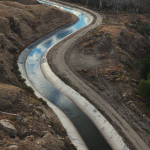Garfield County commissioners agree to major solar generation facility in Spring Valley

The potential for glare affecting passing motorists from a large solar generation facility in Spring Valley should be sufficiently mitigated by existing vegetation and structures.
The 5.38-megawatt project, according to the developers, will include three separate arrays on Colorado Mountain College property just east of the Spring Valley campus. The project was approved unanimously Monday by Garfield County commissioners.
A required glare analysis for the project determined that drivers heading up County Road 114 (CMC Road) from the west could experience glare during certain periods of time in early spring and late summer.
However, such studies only look at topography and don’t take into account the existence of vegetation and buildings that can serve to block the view, Geri Kantor of Ameresco HCE Solar LLC said during a presentation to the commissioners.
Glare can be one of the major impacts associated with large solar generation facilities, especially for motorists on nearby roadways, for adjacent residential areas and, in some cases, for air traffic.
The issue has been extensively studied and mitigation measures developed in many southwestern states where such facilities are becoming more common.
Kantor pointed to an observation by ForgeSolar, which conducts glare studies for solar developers: “Glare analyses do not account for physical obstructions between reflectors and receptors. This includes buildings, tree cover and geographic obstructions.”
Such is the case with the planned 22-acre site where the new Holy Cross Energy (HCE) generation station and battery storage facility is to be constructed, Kantor said.
Neither the college campus nor nearby residential areas would be in the direct line of sight where glare could be an issue, she said.
In any case, should it become an issue, one of the conditions of approval for the Spring Valley facility is to employ mitigation efforts.
The project is being developed by Ameresco Solar in partnership with local electric cooperative HCE and connected to the regional utility’s power grid. The project is part of HCE’s 100×30 strategic plan, which aims to provide 100% renewable power generation by the year 2030.
CMC, which is providing the site, also has a goal to be carbon neutral by 2050, and the Spring Valley campus hopes to be powered by 100% renewable energy with the new facility.
Construction is expected to begin later this summer and take eight months to complete.
The contract with Ameresco is for 20 years, after which Holy Cross could purchase the facility outright and continue operating it.
Another project concern focused on wildlife impacts. Colorado Parks and Wildlife (CPW) indicated the site is in the middle of critical winter habitat for elk and deer herds.
While avoiding the site would be preferred, CPW has agreed to work with Ameresco and HCE on a plan to fund habitat improvements in the adjacent Toner Creek area. That work could be completed before the fall hunting season, Kantor said.
Concerns about wildfire danger associated with the battery storage system also led to a pair of conditions recommended by the Carbondale and Rural Fire Protection District.
In addition to regular vegetation management on the site, such as mowing, the operators are to cut sagebrush and trees back 10 feet from the perimeter fence. The planned battery storage must also comply with current standards for such systems.
Senior Reporter/Managing Editor John Stroud can be reached at 970-384-9160 or jstroud@postindependent.com.




